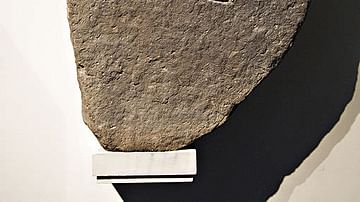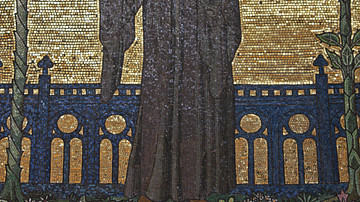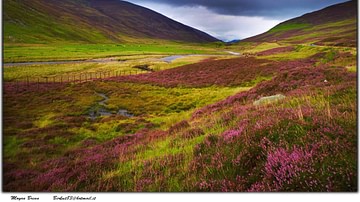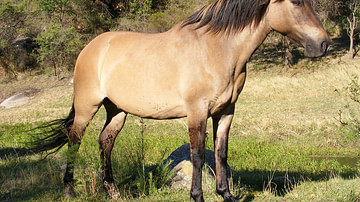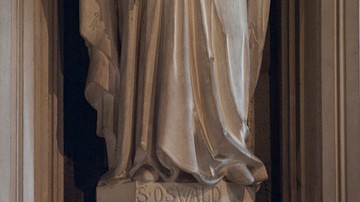
The Battle of Dun Nechtain (also known as The Battle of Dunnichen, The Battle of Nechtanemere, Lin Garan, and The Battle of Nechtan) was a pivotal engagement between the Northumbrians under their king Ecgfrith and the Picts under the leadership of their king Brude Mac Bile (also known as King Bridei III). The battle took place at 3:00 pm (15.00) on Saturday, 20 May, 685 CE. The precise dating of the engagement might suggest that there is thorough documentation of the battle but, actually, aside from the account by the historian Bede (672-735 CE) and possibly the depiction carved on the Aberlemno Stone stone #2, few details are known. The Battle of Dun Nectain stopped the Northumbrian invasions (at least for a time), freed the Scots and Britons from Northumbrian domination, and secured the boundaries of the lands of the Picts. Historians John and Julia Keay note that the battle "may thus have created the circumstances which led to the foundation of Scotland" (271). This claim is further supported by other historians, such as Stuart McHardy, who also notes the lasting importance of this battle in Scottish history.
Northumbria & the Picts
The rise of the Anglican Kingdom of Northumbria, and the fall of the kingdom of Gododdin (which lay between the lands of the Picts and the southern regions of the Angles) increased Angle holdings in Britain and resulted in their regular incursions into Pictish land. The southern Picts were conquered by the Angles and subjugated, as the Scots and Britons had been before them. According to the historians Keay, "By a combination of dynastic, political, and military means, Northumbria came to dominate a large part of southern Pictland. Around 672, following the death of the powerful Northumbrian King Oswin, the Picts attempted to 'throw off the yoke of slavery' but suffered a horrendous defeat at the hands of Oswald's successor Ecgfrith" (271). Ecgfrith then instituted policies to keep the conquered peoples in their place and demanded tribute be paid regularly to the Northumbrian kingdom of Bernicia.
Northumbria had the resources and manpower to take large portions of land from tribes such as the Scots, who had arrived from Ireland and settled in Dalriada and Argyll, and the Britons of Strathclyde, both of whom, as noted, were then subjects of the Angles. One of Ecgfrith's policies was installing kings in certain territories whom he felt would serve his purpose. One of these Pictish kings was Bridei Mac Billi (better known as Brude Mac Bile), who is considered one of the greatest, if not the greatest, of the Pictish kings for halting the advance of the Angles of Northumbria and freeing his lands of their influence. In doing so, he would also remove the Northumbrian yoke from the Britons and the Scots to the south, as well as other tribes, and more or less set the early boundaries of what would later become England, Scotland, and Wales.
The Battle
King Ecgfrith, who was Brude's cousin, may have helped him to power on the condition that Brude would regularly send tribute and would work for Ecgfrith's interests. This claim has been contested, however, and it is also thought that Brude came to power after the Northumbrians defeated the king of the Northern Picts, Drest Mac Donuel, at the Battle of Two Rivers in 670 CE. However Brude came to power, it is clear that he was expected to send tribute south to Northumbria. Brude, however, had no intention of doing so and, although it seems he initially did send tribute in the form of cattle and grain, this practice ended soon after he had consolidated his power. Ecgfrith was hardly pleased with this development but became more upset by Pictish raids into his kingdom south of Hadrian's now crumbling and undefended wall. Ecgfrith decided it was time to remove Brude and teach the Picts an important lesson.
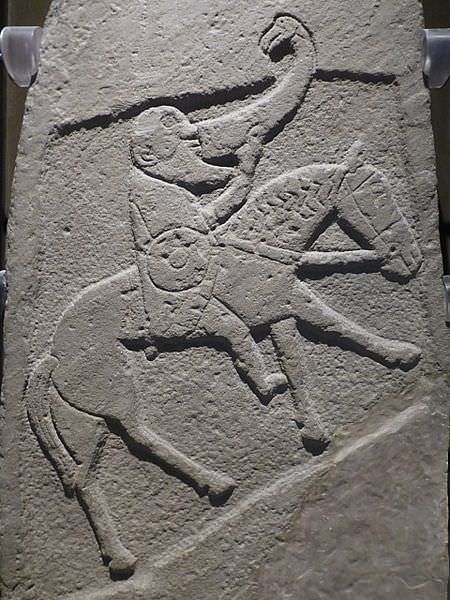
At the same time, Brude was further consolidating his power by subduing rebellious Pictish sub-chiefs. In 681 CE he took the stronghold of Dunottar, and by 682 CE he had a navy of adequate size and strength to sail to Orkney and subdue the tribes there. Following this victory, he took the Scots' capital of Dunadd to the west so that, by 683 CE, he had secured his northern, eastern, and western boundaries (Orkney, Dunnotar, and Dunadd) and only had to concern himself with an attack directly from the south.
This attack came in May of 685 CE when Ecgfrith could no longer tolerate Brude's threats to his rule and refused the counsel of his advisors to try further diplomatic measures. He mobilized a force of cavalry (possibly numbering around 300) to put down what he saw as a Pictish rebellion in his lands. The Picts under Brude lured the Angle force deeper and deeper into their territory by feigning retreat. The Keays observe that "it would appear Brude had a plan which involved avoiding the type of ground that had led to the previous defeat [in 672] and necessitated enticing the Northumbrian army into his choice of territory. He used the local topography to trap his enemy, with Dunnichen Hill and Nectan's Mire playing a crucial role" (271). Once the Angles were securely in his grasp, Brude then struck at a place known to the Scots as Dunnichen, in English chronicles as Nechtansmere, and in Welsh chronicles as Linn Garan; the Annals of Ulster refer to it as Dun Nechtain, and this is the name most commonly referenced by historians. The Angle forces found themselves between the Pictish army on the high ground of Dunnichen Hill, who are said to have numbered in the thousands, and the marshes of the lake Nectan. Ecgfrith, realizing his dangerous position, opted for a full-scale charge of his cavalry uphill to break the Picts' line in the center. Brude, however, fell back, feigning retreat, and then turned and held the line. He repulsed the charge, sending the Angles reeling in retreat back down the hill and toward the marshes; then he counter-charged. The historian Bede, who gives the most detailed account of the battle, writes:
King Ecgfrith, ignoring the advice of his friends...rashly led an army to ravage the province of the Picts. The enemy pretended to retreat, and lured the king into narrow mountain passes, where he was killed with the greater part of his forces on the twentieth of May in his fortieth year and the fifteenth of his reign. As I have said, his friends warned him against this campaign; but in the previous year he had refused to listen to the reverend father Egbert, who begged him not to attack the Irish who had done him no harm; and this was his punishment, that he now refused to listen to those who tried to save him from destruction. Henceforward the hopes and strength of the English realm began to waver and decline, for the Picts recovered their own lands that had been occupied by the English, while the Scots living in Britain and a proportion of the Britons themselves regained their freedom. Many of the English at this time were killed, enslaved, or forced to flee from Pictish territory (Chapter 26).
Aftermath
The Battle of Dun Nechtain broke Northumbria's power and secured the borders of the lands of the Picts, which later would become Scotland. It also drove the Christian missionaries of the Angles (Roman Catholicism) out of Pictish lands, allowing the original Columban brand of Christianity (the Celtic Church) to take hold in the highlands instead of the Roman brand, which had been accepted by the Angles. Brude continued to rule until his death in 693 CE, by which time his kingdom was secure and at peace.
This peace would not last long, however, as his later successor, Nechtan Mac Derile (706-724 CE), would open negotiations with the Angles on religious matters and begin a ten-year religious conflict in the kingdom between those who favored the Celtic Church and those who believed in the teachings of the Roman Catholic brand of Christianity. In spite of these conflicts, however, Brude Mac Derile had forged a unified nation which would be brought back together under the reign of King Oengus son of Uurguist in 734 CE. Oengus, and those who came after him, would repeatedly have to deal with Angle attempts to invade and conquer the land of the Picts, and this paradigm would continue through the reign of Kenneth Mac Alpin (843-858 CE) and on past the last king of the Picts, Giric, who died in 899 CE. The wars between the Angles (later the English) and the Picts (who merged with the Scots) are legendary in history and continued for centuries, but the Battle of Dun Nechtain in 685 CE established the later boundaries the two peoples would fight over and set the stage for the establishment of Scotland.
